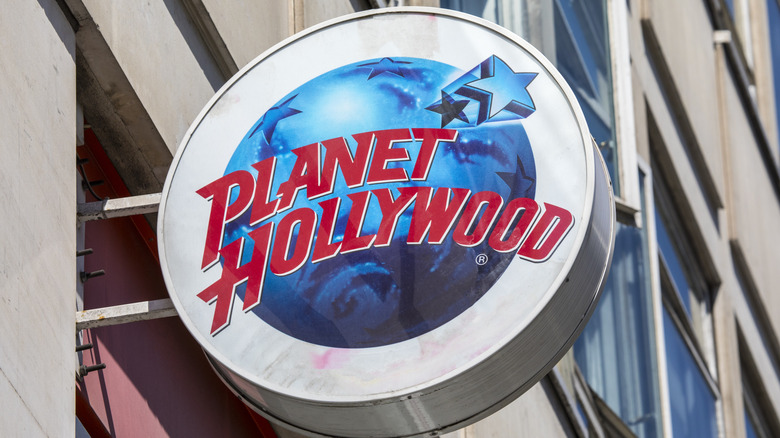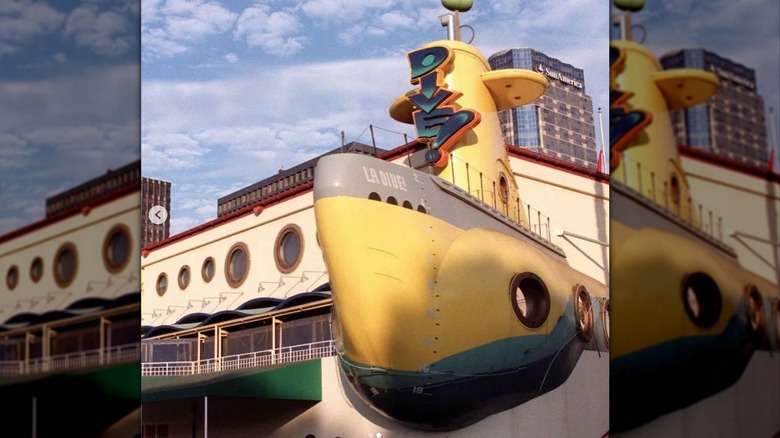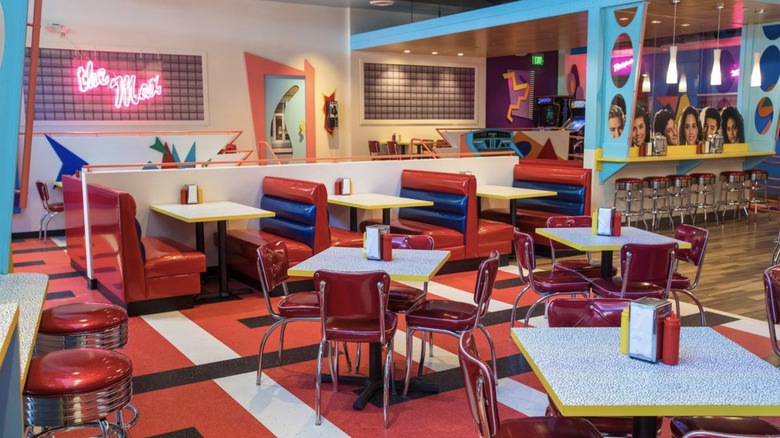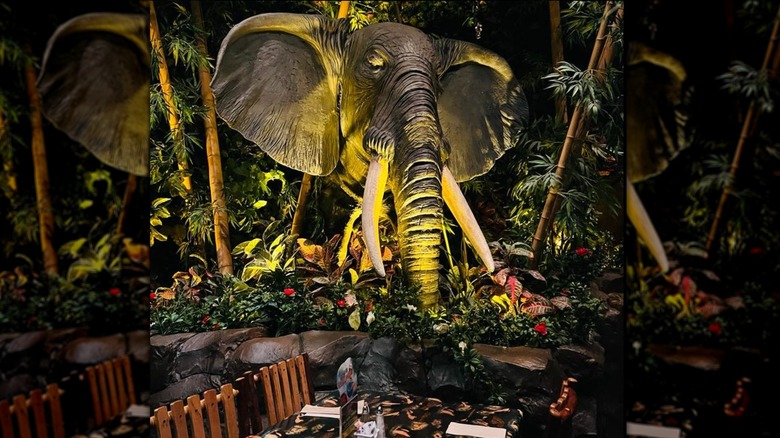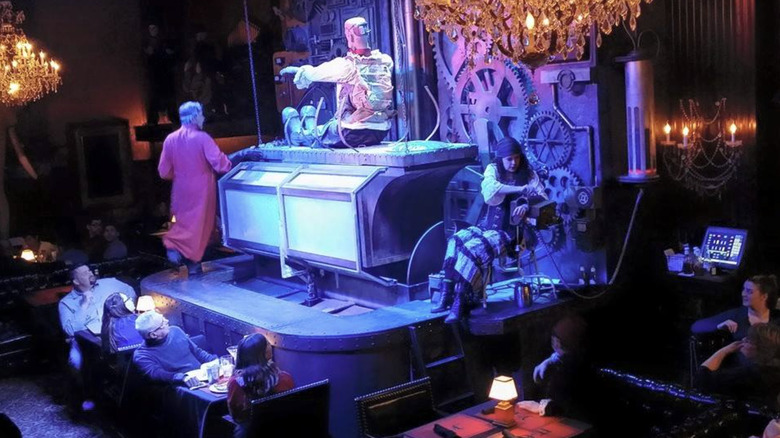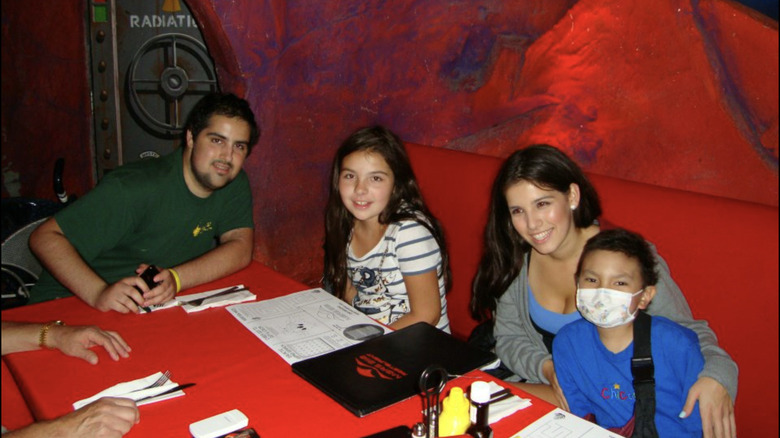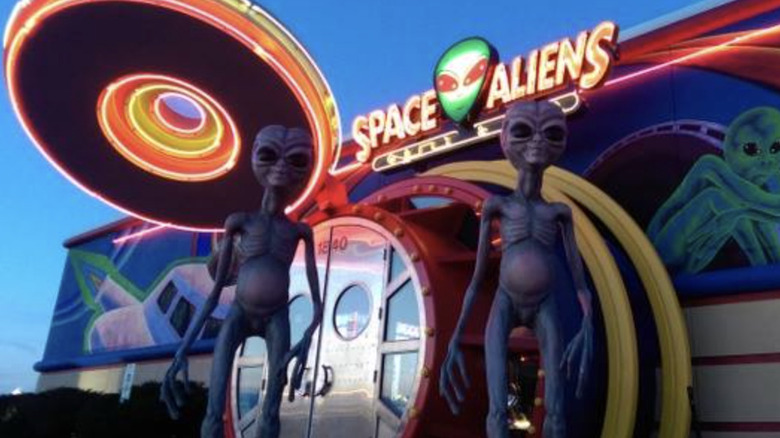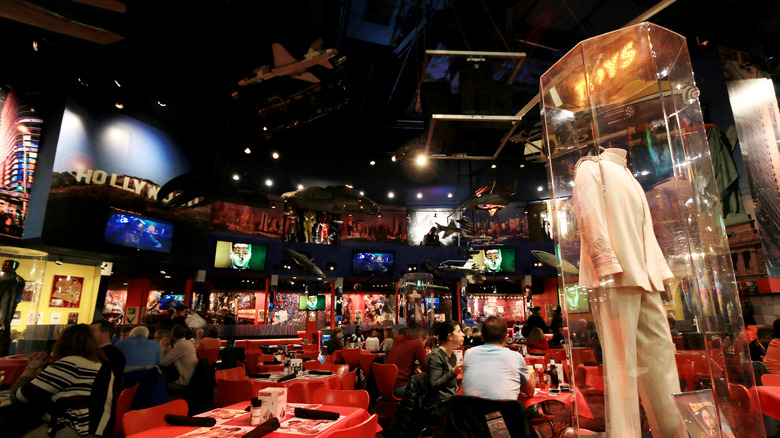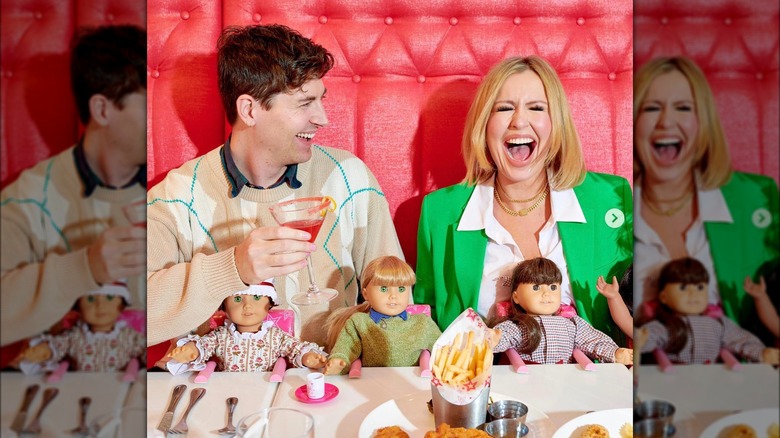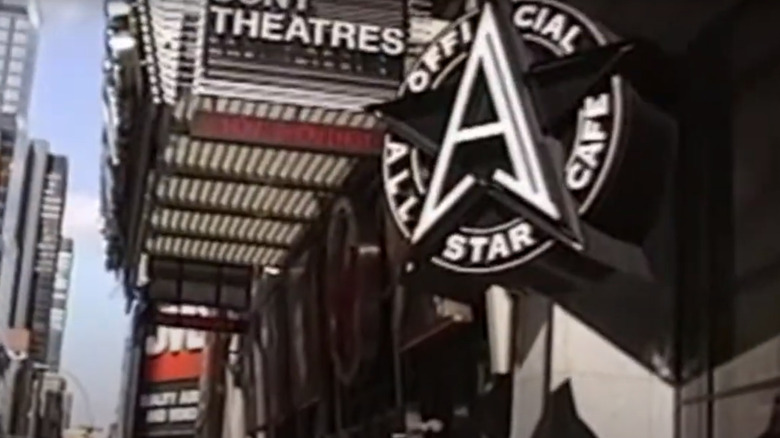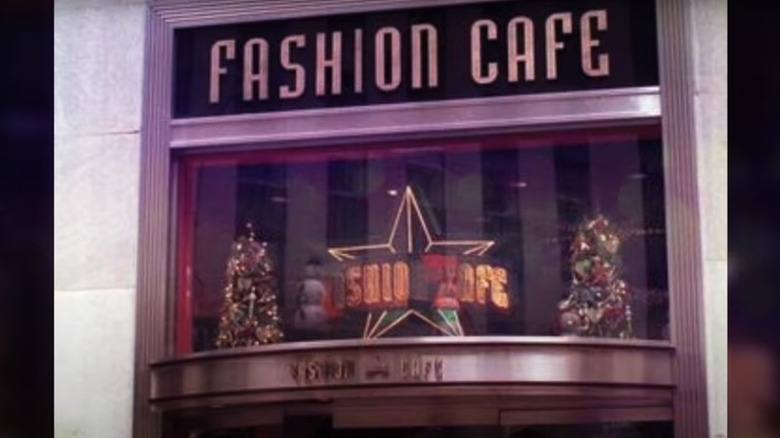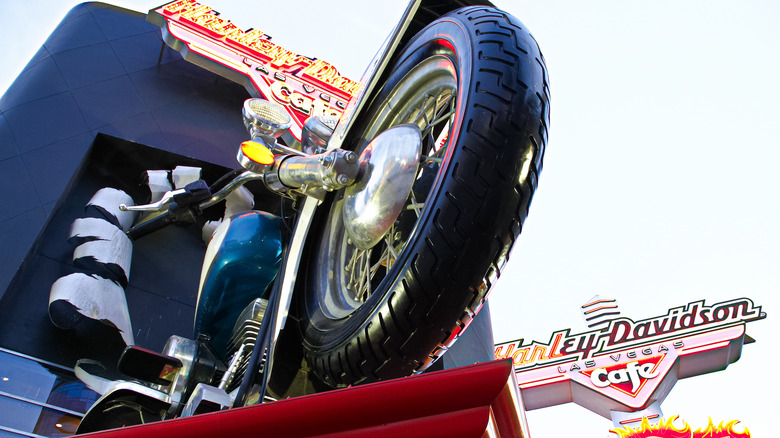'90s Themed Restaurants You Forgot Existed
The inception of themed restaurants where the concept behind the venture is at least as important as its food can be traced to late 19th century Paris and the emergence of cafe cabarets. One such notable establishment was Café du Bagne, which opened in 1885. This unique cafe emulated the atmosphere of a penitentiary dining hall, complete with servers dressed as convicts and faux balls and chains.
It wasn't long before the States — and particularly New York City — caught on, embracing the immersive journey offered by themed cafes. At the turn of the 20th century, breakfast dungeons started appearing across the city. These intriguing establishments invited patrons to dress in butcher's aprons, sit on a rustic box, and dig into their meal — usually a steak — with bare hands. And as the restaurant name suggests, the setting was typically a dark basement.
By the time the '90s rolled around, themed restaurants were well and truly ingrained in the American psyche. By bringing together bespoke decor and staff in themed attires, these restaurants offered culinary adventures that went beyond the everyday meal. From restaurants inspired by famous Hollywood blockbusters to eateries that simulated daring cosmic adventures, these establishments were all the rage ... until they weren't. As the new millennium approached, some of these once-thriving establishments were forced to close their doors while others managed to adapt and endure.
Keen to find out more about the bygone era of culinary adventures? Check out our list of the '90s-themed restaurants you forgot existed.
Dive!
Dive! was Steven Spielberg's submarine-themed vision that made a splash on the LA dining scene in 1994 ... well, sort of. Apparently, the film director and producer had been captivated by subaquatic voyages since reading Jules Verne's "20,000 Leagues Under the Sea" as a child. The idea for the restaurant sprouted into reality through a partnership with Jeffrey Katzenberg, resulting in the creation of a 300-seat restaurant with a submarine-inspired exterior.
The restaurant's interior offered a literally immersive experience with flashing lights and portholes that filled up with water every 45 minutes to evoke the sensation of taking a plunge into the unknown. Spielberg invested a cool $7 million into the venture with a plan for 60 more Dive! restaurants across the world. In reality, he only managed to open another location in Las Vegas before the entire endeavor started to sink.
Unfortunately, Dive! didn't share the same fate with Spielberg's iconic movies such as "Jaws," "Indiana Jones," and "E.T.," with the LA location closing its doors in 1999 and the Vegas location shortly after. It appears that underwhelming merch sales (including $5 souvenir menus) and hit-or-miss food may have been the main culprits behind the restaurant's demise. Michelle Huneven, who reviewed Dive! for the Los Angeles Times, didn't seem overly impressed with the fare, saying, "A special entrée, oven-roasted salmon steak, loses points for dryness. The meat in the chicken salad is also overdone. Caesar dressing is too gummy to soak into croutons."
Saved by the Max
If you were a '90s kid, chances are you were a fan of "Saved by the Bell," a coming-of-age television series about a bunch of friends navigating the ups and downs of teenage life. For a lucky few, the nostalgia of this beloved sitcom was temporarily brought back to life at Saved by the Max, a pop-up restaurant that recreated the magic of the show in L.A. and Chicago.
A reproduction of The Max — the local hang-out of the characters from "Saved by the Bell" — Saved by the Max was a treasure trove of memorabilia. Some of the props included Bayside High lockers, each with a detail specific to their owner, including Jessie's caffeine pill bottles and Zack's old school cell phone. Some other retro elements included a jukebox, video game consoles, neon graphics, and a boxy public telephone. The restaurant's patrons could also dine in a replica of the office of the Bayside High principal, Mr. Belding.
Saved by the Max's menu included a selection of dishes, many creatively named to pay homage to Bayside and its beloved characters. Just a few of the choices included Tori's Fried Chicken, Mac & Screech, and A.C. Sliders. A huge red flag indicating that Saved by the Max was definitely not The Max from the sitcom — in case there was ever any confusion — was the pop-up's lengthy bar and drink selection, with offerings such as the Zachary Daiquiri or the Albert Clifford.
Rainforest Cafe
With the possible exception of the disappearance of the live parrots, things have changed little at the Rainforest Cafe since the opening of its first location in Minnesota in 1994. Recreating the experience of dining amid the lush vegetation of a rainforest, the restaurant still entertains patrons with animatronic elephants, crocodiles, and gorillas, as well as simulated tropical rainstorms. Standing testament to its success, there are currently 16 Rainforest Cafes across the U.S., with six outlets also located in the United Arab Emirates, Canada, France, Japan, and Malta.
The Rainforest Cafe is the brainchild of Steven Schussler who initially spent around $400,000 to prototype the restaurant concept in his own home. Struggling to pitch the concept of the cafe to potential backers, he engineered the entire rainforest scenario at his Minneapolis abode, installing artificial greenery and waterfalls, as well as a top-of-the-range lighting and sound system. In his memoir "It's a Jungle in There," Schussler recounts housing a remarkable menagerie comprising "40 tropical birds, two 150-pound tortoises, a baboon, an iguana, and a plethora of tropical fish accommodated in 10 300-gallon fish tanks.
Just like when the Rainforest Cafe first opened, food still plays second fiddle to the restaurant's immersive experience. Despite the elaborate setup, the menu is surprisingly run-of-the-mill. Think ribs, tacos, fried shrimp, cheese sticks, burgers, pasta, and salads. Perhaps the most exotic dish you'll find on the menu is the Korean fried chicken lettuce wraps.
Jekyll & Hyde Club
The appeal of the Jekyll & Hyde Club lay in its eerie animatronics, which added a whole new dimension to dining. Whether the restaurant's creepy special effects lived up to patrons' expectations, however, is a matter of debate and speculation, as the Jekyll & Hyde Club no longer exists. Opened in 1991 in New York City, the restaurant and bar chain expanded to several locations around the country before closing for good in 2022.
Once a favorite for birthday parties, group gatherings, and corporate events, the Jekyll & Hyde Club in New York featured four themed floors, including the Library, the Grand Salon, the Laboratory, and the Attic, each with its own lineup of creepy animatronics and props. The restaurant was also home to a motley crew of characters including Tobias the Werewolf, Dreadmina the Vampire, and Claw the Gargoyle. To create a truly immersive experience, Jekyll & Hyde Club's animatronics and other entertainment sprang to life every 10 minutes. And true to its name, the restaurant's patrons could also experience Dr. Jekyll's metamorphosis into Mr. Hyde as they munched on Create-Your-Own-Monster burgers, pizzas, pastas, and salads.
Mars 2112
Described as a "Times Square tourist trap" and a "truly baffling experience," Mars 2112 was a 33,000-square-foot restaurant complex built around the concept of intergalactic voyages. Constructed at a staggering cost of $8.5 million and unveiled in the late '90s, the extravaganza featured neon lights, lava pools, arcade games, and a crew of friendly aliens. In its heyday, the Mars-themed restaurant welcomed the likes of Brad Pitt and Maddox Jolie-Pitt and Bill Clinton and his niece.
Upon arrival, guests boarded a shuttle ride — a 747 flight simulator — that transported them from the entrance to the dining table. Called the Crystal Crater, the three-story dining area was decked out to resemble an underground Martian landscape that opened up to vistas of the heavens beyond. Meanwhile, the dishes came complete with cosmic-inspired names. Rather than offering Martian cuisine, however, Mars 2112 served burgers, steaks, and pasta.
Despite all the effort, Mars 2112 filed for bankruptcy both in 2002 and 2007 before permanently closing its doors in 2012. The restaurant's slew of memorabilia, including its two $1.5 million flight simulators, were auctioned off to recoup some of the financial losses. Despite not winning over everyone with the interstellar concept, it's clear that many kids were enamored with the adventurous theme. One former patron recounted, "It was fun to have a place that was dark, loud, and kind of unconcerned if children were loud and annoying."
Space Aliens Grill & Bar
As you enter the Space Aliens Grill & Bar, you step into a one-of-a-kind world where fluffy green aliens with large eyes and barbecue ribs are the order of the day. Having opened its flagship location in Bismarck, North Dakota, in 1997, the restaurant is still in business. While a handful of Space Aliens Grill & Bar outlets have come and gone, the regional chain can still be found in Fargo, North Dakota, and Albertville, Minnesota. Interestingly, the founder of Space Aliens Grill & Bar, Mort Bank, hit the spotlight in 2012 when he managed to sell a gallon of McDonald's "McJordan BBQ Sauce" for a sweet $9,995 on eBay.
While the three outlets are all slightly different, it's hard, perhaps even impossible, to miss Space Aliens Grill & Bar's futurism-inspired vintage exterior. All locations feature a 30-foot-high domed ceiling with vistas of the cosmos, as well as sculptures of aliens. There're also arcade games to keep the entire family entertained.
Perhaps one of the reasons that the regional chain has remained operational is its food. Unlike many themed restaurants, the Space Aliens Grill & Bar seems to take its fare seriously. The restaurant specializes in fire-roasted pizzas and barbecue ribs, but also serves burgers, steaks, and salads. In fact, as we touched upon earlier, the Space Aliens Grill & Bar's barbecue ribs have won the accolade of America's best ribs at the National Bar-B-Que Convention Cook-off in Memphis, Tennessee.
Planet Hollywood
Founded by then-CEO of the Hard Rock Cafe Robert Earl and film producer Keith Barish, Planet Hollywood had some impressive celebrity backers, including Bruce Willis, Arnold Schwarzenegger, and Sylvester Stallone. The film-themed cafe made its grand debut in New York in 1991, attracting film icons such as Michael J. Fox and Alec Baldwin, as well as a crowd of around 10,000 devoted fans. While the '90s saw Planet Hollywood grow to dozens of restaurants across the globe, this number has now dwindled to just four outlets in Orlando, Los Angeles Airport, Malta, and Qatar.
Apart from the thrill of catching a glimpse of an A-lister, Planet Hollywood's biggest drawing card was its collection of movie costumes and memorabilia. Some of the props on display at the restaurant included the pottery wheel from "Ghost" and Dorothy's dress from "The Wizard of Oz." And the venture wasn't cheap — each location cost approximately $2 million to set up and open.
Unfortunately, over time, the novelty of the concept began to fade. Coupled with lackluster food offerings that failed to impress customers (with the possible exception of the chicken fingers basket known as the "chicken crunch") the restaurant witnessed a decline in its customer base. This downturn became evident when the company filed for bankruptcy not once, but twice. Complicating the situation even further, in 1992, Planet Hollywood was sued by the Hard Rock Cafe, which accused it of imitating the music-themed chain and delivering a "similar but of substantially lower quality" experience.
American Girl Cafe
A part of select American Girl stores, which sell a line of dolls representing different backgrounds and historical periods, the American Girl Cafe has been around since launching in Chicago in 1998. Even if you don't have an American Girl doll to accompany you for dinner, there's no need to worry. There's usually a plethora of different dolls to choose from as you enter the premises. You can pick the company of Samantha Parkington, a historical doll from the progressive era of early 20th century America, or opt to dine with Courtney Moore, an arcade game wizard.
Open for brunch, lunch, afternoon tea, and dinner, as well as parties, the American Girl Cafe is a cacophony of bright colors, floral patterns, and upholstered booths. Each doll has her own little seat, which is clamped onto the edge of the table. There's also a box of conversation starters — for those awkward moments of silence — with thought-provoking questions such as, "If you could donate $100,000 to a charity, which one would you choose?" or "Is cheerleading a sport?"
Dining at the American Girl Cafe is on a time-slot basis, with each group of diners served at the same time. Most meals are composed of multiple courses. Alana Bracken, who reviewed the cafe for Bustle, said that his three-course meal "beautifully navigated the line between kid-friendly and adult-appropriate. For every 'fancy' bowtie pasta and chicken finger dish, there was a Cobb salad or a club sandwich with sweet potato fries."
Official All-Star Cafe
Masterminded by Robert Earl and the Planet Hollywood Corporation, the Official All-Star Cafe was meant to replicate the success of its older sibling, except in the realm of professional athletes rather than movie stars. Just like with the Planet Hollywood venture, Earl wasted no time in enlisting prominent figures as investors, including Andre Agassi, Shaquille O'Neal, and Monica Seles. Regrettably, despite its rapid rise to fame, the Official All-Star Cafe also faced a swift downfall, mirroring the fate of Planet Hollywood.
Opened in 1995 in New York City, the chain's flagship outlet came complete with sports memorabilia, including such fascinating decor pieces as Andre Agassi's ponytail, TV screens that televised sports events, baseball glove-inspired booths, and "stadium cuisine" like burgers and chicken wings. While in its heyday, the Official All-Star Cafe had 10 locations, its success was short-lived. The first venue closed in 1999 after the company filed for bankruptcy with others following suit. The last Official All-Star Cafe — which had been purchased by Disney — closed in 2007.
Fasion Cafe
Making its grand debut in New York City in 1995, the Fashion Cafe was billed as the playground of supermodels Naomi Campbell, Claudia Schiffer, Elle Macpherson, and Christy Turlington. In reality, the venture was the brainchild of entrepreneur brothers Tommaso and Francesco Buti and of course the models were paid for their appearances.
Referred to as a "couture version of Planet Hollywood and the Hard Rock Cafe" by the Associated Press, the Fashion Cafe burst onto the scene with a star-studded event complete with tunes by Duran Duran and The Spin Doctors. In contrast, the seven-page-long menu featured low-brow delights such as Naomi Campbell's fish and chips, Elle Macpherson's shrimp on the barbie, and Claudia Schiffer's apple pancakes. Seven more Fashion Cafes followed suit, opening in various locations around the world.
To say that the Fashion Cafe ended up being a flop would be an understatement, with all eight Fashion Cafes closing their doors by 1999. A year later, the Buti brothers were indicted on 51 charges of money laundering and fraud, including swindling investors out of around $12 million to fund their extravagant lifestyles. As a fascinating aside, one of the brothers behind the scheme was given a full pardon by President Donald Trump in 2021.
Harley Davidson Cafe
Opening in 1997, the Harley Davidson Café in Las Vegas enjoyed close to two decades in business before closing its doors forever in 2016. Considering the fate of other themed restaurants, this is no small feat. Having hosted celebrity guests such as Pamela Anderson, Jon Voight, and Burt Reynolds, the Strip cafe was a biker's paradise. The interior featured Harley Davidson choppers, some suspended on moving conveyor belts, and a huge range of memorabilia, such as Jon Bon Jovi's snakeskin jacket and a towering American chain link flag. When it came to the fare, the Harley Davidson Cafe specialized in casual American favorites such as barbecued meats, burgers, and sandwiches.
Following its closure, the Harley Davidson Cafe auctioned off over 350 display pieces, ranging from a prop of the Captain America motorcycle from the film "Easy Rider" to a 20-foot metal eagle. There were also plenty of items signed by famous celebrities, including a guitar signed by Bon Jovi, an autographed photo of Cher sitting on a Harley, and even memorabilia signed by Elvis Presley.
